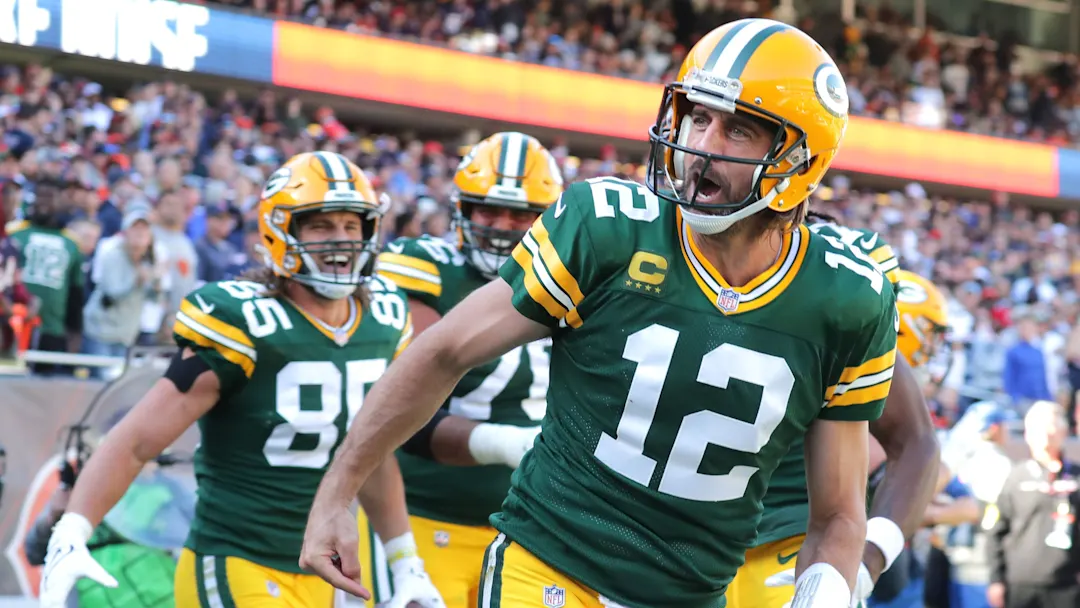Aaron Rodgers joining the Pittsburgh Steelers has sent shockwaves throughout the NFL, not just because of what it means for Rodgers and his new team, but also because of the profound ripple effect it has created for the Chicago Bears. For years, the Bears and Rodgers have been intertwined in a complex narrative of rivalry, missed opportunities, and moments that felt almost scripted for dramatic effect. Now, with Rodgers donning the black and gold, the Bears find themselves standing at a critical crossroads — a last chance at redemption against a former face of their franchise who has become a formidable adversary.
To truly grasp the weight of this moment, it’s important to rewind and consider the history between Rodgers and the Bears. Drafted by the Green Bay Packers in 2005, Rodgers quickly rose to become one of the greatest quarterbacks of his generation. Throughout his tenure in Green Bay, Rodgers was not just a leader for the Packers but also a fierce competitor in the NFC North division. The Bears, as their long-time divisional rivals, bore the brunt of many of Rodgers’ career-defining moments. From clutch comebacks to crucial victories, Rodgers repeatedly left the Bears scrambling and often questioning their own identity as a franchise.
The rivalry between the Packers and Bears is one of the most storied in NFL history, stretching back over a century with fierce battles, legendary players, and passionate fanbases on both sides. Rodgers was always the lightning rod for the Packers’ dominance in recent years, frequently outshining Chicago’s efforts with his precision, athleticism, and football IQ. Despite the Bears’ passionate fan base and rich history, the Packers often held the upper hand, and Rodgers was a symbol of that dominance.
However, this new chapter — Rodgers joining the Steelers — flips the script in a way few could have anticipated. Suddenly, the Bears are not just chasing the ghost of their divisional nemesis but are now confronted with a renewed challenge on a different battleground. The rivalry’s intensity might shift away from the traditional NFC North clash, but the emotional stakes remain just as high. For the Bears, this is a moment brimming with possibility and urgency: the chance to finally reclaim pride and prove that they can rise above the shadow cast by Rodgers.
This transition for Rodgers also reflects a larger narrative about reinvention and resilience in professional sports. After years of success in Green Bay, Rodgers’ move to Pittsburgh signals a fresh start, a new opportunity to redefine his legacy with a different franchise and fanbase. For the Steelers, a storied franchise with its own proud tradition, adding Rodgers brings a surge of optimism and expectation. They are banking on Rodgers’ experience and leadership to push the team deep into the playoffs and maybe even contend for another Super Bowl title.
Yet, the Steelers aren’t the only ones watching this play out. Bears fans, players, and management are undoubtedly energized — and perhaps a bit anxious — about what Rodgers’ arrival in Pittsburgh means for their own future. This isn’t just about facing Rodgers on the field anymore; it’s about what his presence means for the broader NFL landscape and the Bears’ place within it.
The Bears have long struggled to find consistency at the quarterback position since Rodgers took over the NFC North throne. Multiple quarterbacks have come and gone, and the franchise has searched tirelessly for the right fit to lead the team back to prominence. The addition of Rodgers to a nearby rival team like the Steelers only adds fuel to that fire. It’s a reminder of what the Bears could have had and what they might yet achieve if they can make the right moves going forward.
From a competitive standpoint, Rodgers joining the Steelers changes several dynamics. The Steelers, historically known for their dominant defense and powerful running game, now have a quarterback capable of elevating their passing attack to a new level. This not only makes the Steelers a more balanced and dangerous team but also raises the stakes for any upcoming Bears-Steelers matchups. The Bears will face Rodgers not just as a legendary figure of their past but as a tangible threat on the field, steering a dangerous offense that can challenge their defense.
For Bears fans, this storyline brings a complex mix of emotions. There’s the sting of having lost a franchise icon to another team — especially a rival like the Steelers — but there’s also a renewed sense of hope. Hope that the Bears can channel this moment, use the rivalry’s rekindling as motivation, and finally step out of Rodgers’ shadow. The narrative of redemption is powerful in sports because it taps into the human desire to overcome adversity, prove doubters wrong, and rewrite history. For the Bears, this feels like one of those defining moments.
The players on the Bears roster will also be keenly aware of the challenge ahead. Facing Aaron Rodgers is never easy. His ability to read defenses, deliver pinpoint passes, and perform under pressure is legendary. Now, he’s armed with a fresh set of weapons in Pittsburgh and is presumably more motivated than ever to prove himself outside of Green Bay. The Bears’ defense will need to be at its absolute best to contain Rodgers, and the offense will have to capitalize on every opportunity to outscore a team led by one of the best quarterbacks of all time.
Off the field, this move has sparked a frenzy among analysts, commentators, and fans alike. Social media is buzzing with debates about Rodgers’ impact on the Steelers, the Bears’ chances to respond, and how this shift reshapes the NFL’s competitive balance. Sports talk shows and podcasts are dissecting every angle — from coaching strategies to player matchups and draft implications. The storyline practically writes itself: a former franchise legend now an adversary, the Bears’ quest for redemption, and the high-stakes rivalry renewed in an unexpected way.
But beyond all the drama and hype, there’s a deeper story about identity, loyalty, and the evolution of professional football. The NFL is a business as much as it is a sport, and players like Rodgers make decisions not only based on legacy but also on opportunity and timing. The Bears must now reflect on their own approach to team building, quarterback development, and leadership if they want to capitalize on this moment. It’s a chance to learn from the past, build a team that can compete at the highest level, and embrace the challenge that Rodgers’ move presents.
As the new season approaches, all eyes will be on the Bears and Steelers to see how this new rivalry chapter unfolds. Will the Bears rise to the occasion and finally seize their moment of redemption? Or will Rodgers continue to write his own legacy of dominance, this time in Steelers black and gold? The answers will come on the field, in the crunch moments of games where legacies are made and hearts are tested.
One thing is clear: Aaron Rodgers joining the Steelers is more than just a player changing teams. It’s a catalyst for a dramatic new era, reigniting a rivalry steeped in history and emotion, and giving the Chicago Bears their last shot at redemption in a high-stakes, fiercely contested showdown. For the Bears and their fans, the road ahead may be challenging, but it’s also charged with the promise of greatness — if they can seize it.



